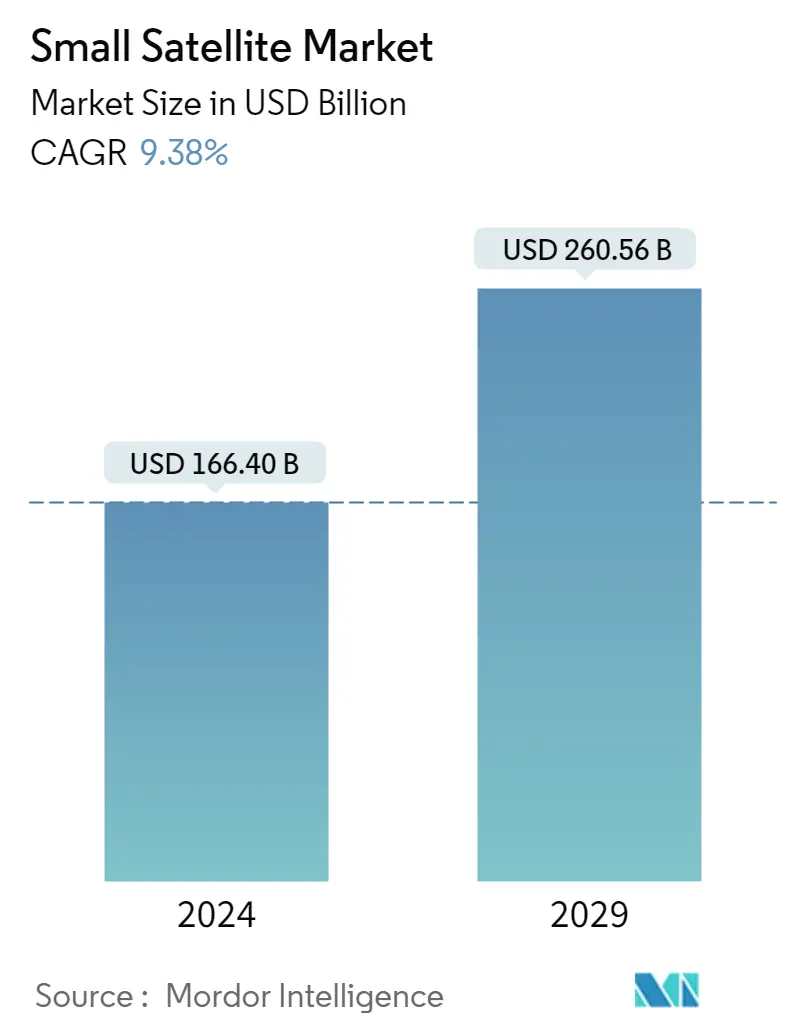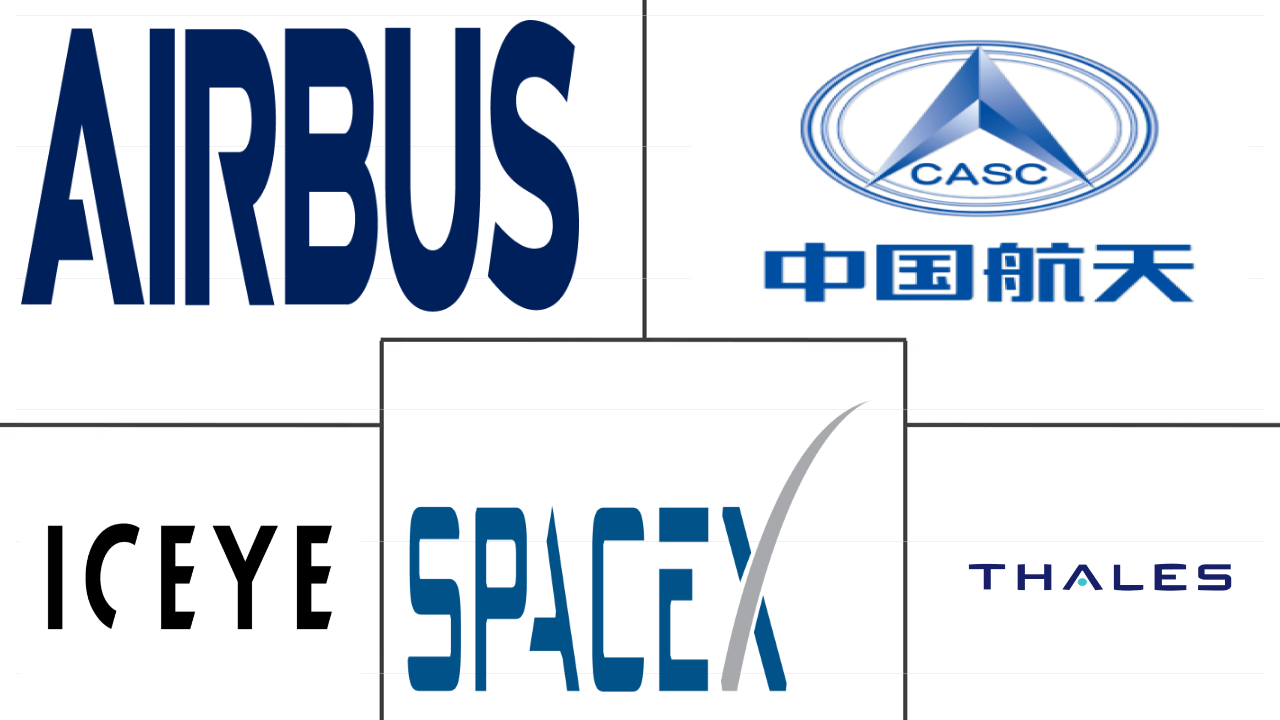Market Size of small satellite Industry

|
|
Study Period | 2017 - 2029 |
|
|
Market Size (2024) | USD 166.40 Billion |
|
|
Market Size (2029) | USD 260.56 Billion |
|
|
Largest Share by Orbit Class | LEO |
|
|
CAGR (2024 - 2029) | 9.38 % |
|
|
Largest Share by Region | North America |
Major Players |
||

|
||
|
*Disclaimer: Major Players sorted in no particular order |
Small Satellite Market Analysis
The Small Satellite Market size is estimated at USD 166.40 billion in 2024, and is expected to reach USD 260.56 billion by 2029, growing at a CAGR of 9.38% during the forecast period (2024-2029).
166.40 Billion
Market Size in 2024 (USD)
260.56 Billion
Market Size in 2029 (USD)
118.39 %
CAGR (2017-2023)
9.38 %
CAGR (2024-2029)
Largest Market by Satellite Subsystem
80.28 %
value share, Propulsion Hardware and Propellant, 2022
The demand for these propulsion systems is driven by the launch of mass satellite constellations into space. They are used for transferring the spacecraft into orbit.
Largest Market by Application
95.62 %
value share, Communication, 2022
Governments, space agencies, defense agencies, private defense contractors, and private space industry players are emphasizing the enhancement of the communication network capabilities for various public and military reconnaissance applications.
Largest Market by Orbit Class
99.74 %
value share, LEO, 2022
LEO satellites are increasingly being adopted in modern communication technologies as they play an important role in Earth observation applications.
Largest Market by Region
91.16 %
value share, North America, 2022
The increasing investments in satellite equipment to enhance the defense and surveillance capabilities the construction of critical infrastructure, and the rise in law enforcement agencies using satellite systems are key factors driving the market in North America.
Leading Market Player
85.79 %
market share, Space Exploration Technologies Corp., 2022

SpaceX is the leading player in the global satellite manufacturing market and maintains its market share globally through its Starlink project in over 53 countries. The company produces 120 satellites per month.
LEO satellites dominate the market's growth by occupying majority of the market share
- A satellite or spacecraft is usually placed into one of many special orbits around the Earth or launched into an interplanetary journey. Small satellites revolutionized the space industry in recent years as they have enabled low-cost access to space for a wide range of applications, from scientific research to commercial and military applications. To fully realize the potential of small satellites, it is essential to understand the different types of orbits they can be launched into. Most science satellites, including NASA's Earth Observation System, are in low Earth orbit.
- The small satellite market continues to experience strong growth, driven by the increasing demand for LEO satellites used for communication, navigation, Earth observation, military reconnaissance, and scientific missions. Between 2017 and 2022, around 2900 small LEO satellites were manufactured and launched, primarily used for communication purposes. This led companies such as SpaceX, OneWeb, and Amazon to plan the launch of thousands of satellites into LEO. With the rising demand for low earth orbit from various sectors like Earth observation, navigation, meteorology, and military communications, the market has witnessed a rise in the number of launches of LEO satellites.
- Though the launch of small satellites into GEO and MEO is very few in recent years, despite this fact, the military's use of MEO and GEO satellites has grown. It is also expected to increase, owing to the advantages, such as increased signal strength, improved communications and data transfer capabilities, and greater coverage area. For instance, Raytheon Technologies' and Boeing's Millennium Space Systems are developing the first prototype Missile Track Custody (MTC) MEO OPIR payloads for the US Space Force.
North America may witness significant growth during the forecast period
- The global small satellite market is expected to grow significantly in the coming years, driven by increasing demand for high-speed internet, communication services, and data transfer across different industries. The market is analyzed with respect to North America, Europe, and Asia-Pacific, which are the major regions in terms of market share and revenue generation.
- North America is expected to dominate the global small satellite market during the forecast period due to the presence of several leading players, such as Swarm Technologies, Planet Labs, and SpaceX. The US government has also been investing heavily in developing advanced satellite technology, which is expected to drive the North American small satellite market. During 2017-2022*, the region accounted for 75% of the total small satellites manufactured.
- The small satellite market in Europe is expected to grow significantly during the forecast period due to the rising demand for high-speed internet and communication services. The European Space Agency (ESA) has been investing heavily in developing advanced satellite technology, which is expected to drive the growth of the European small satellite market. During 2017-2022*, the region accounted for 13% of the total small satellites manufactured.
- Asia-Pacific is expected to witness significant growth in the small satellite market during the forecast period due to the increasing demand for satellite-based communication services and navigation systems in countries such as China, India, and Japan. During 2017-2022*, the region accounted for 6% of the total small satellites manufactured.
Small Satellite Industry Segmentation
Communication, Earth Observation, Navigation, Space Observation, Others are covered as segments by Application. GEO, LEO, MEO are covered as segments by Orbit Class. Commercial, Military & Government are covered as segments by End User. Electric, Gas based, Liquid Fuel are covered as segments by Propulsion Tech. Asia-Pacific, Europe, North America are covered as segments by Region.
- A satellite or spacecraft is usually placed into one of many special orbits around the Earth or launched into an interplanetary journey. Small satellites revolutionized the space industry in recent years as they have enabled low-cost access to space for a wide range of applications, from scientific research to commercial and military applications. To fully realize the potential of small satellites, it is essential to understand the different types of orbits they can be launched into. Most science satellites, including NASA's Earth Observation System, are in low Earth orbit.
- The small satellite market continues to experience strong growth, driven by the increasing demand for LEO satellites used for communication, navigation, Earth observation, military reconnaissance, and scientific missions. Between 2017 and 2022, around 2900 small LEO satellites were manufactured and launched, primarily used for communication purposes. This led companies such as SpaceX, OneWeb, and Amazon to plan the launch of thousands of satellites into LEO. With the rising demand for low earth orbit from various sectors like Earth observation, navigation, meteorology, and military communications, the market has witnessed a rise in the number of launches of LEO satellites.
- Though the launch of small satellites into GEO and MEO is very few in recent years, despite this fact, the military's use of MEO and GEO satellites has grown. It is also expected to increase, owing to the advantages, such as increased signal strength, improved communications and data transfer capabilities, and greater coverage area. For instance, Raytheon Technologies' and Boeing's Millennium Space Systems are developing the first prototype Missile Track Custody (MTC) MEO OPIR payloads for the US Space Force.
| Application | |
| Communication | |
| Earth Observation | |
| Navigation | |
| Space Observation | |
| Others |
| Orbit Class | |
| GEO | |
| LEO | |
| MEO |
| End User | |
| Commercial | |
| Military & Government | |
| Other |
| Propulsion Tech | |
| Electric | |
| Gas based | |
| Liquid Fuel |
| Region | |
| Asia-Pacific | |
| Europe | |
| North America | |
| Rest of World |
Small Satellite Market Size Summary
The small satellite market is experiencing robust growth, driven by the increasing demand for low Earth orbit (LEO) satellites across various sectors such as communication, navigation, Earth observation, and military reconnaissance. These satellites have transformed the space industry by providing cost-effective access to space, enabling a wide range of applications from scientific research to commercial and military uses. The market is characterized by the rapid development and launch of small satellites, which are capable of performing nearly all tasks of conventional satellites at a fraction of the cost. This has led to a significant rise in the number of LEO satellite launches, with major companies like SpaceX, OneWeb, and Amazon planning extensive satellite constellations. Despite fewer launches into geostationary and medium Earth orbits, military applications in these areas are expected to grow due to benefits like enhanced signal strength and improved communication capabilities.
Regionally, North America is anticipated to dominate the small satellite market, supported by leading players and substantial government investment in advanced satellite technology. Europe is also poised for significant growth, driven by the European Space Agency's investments and rising demand for high-speed internet and communication services. The Asia-Pacific region is expected to witness notable expansion due to increasing demand for satellite-based communication and navigation systems in countries like China, India, and Japan. The market is fairly consolidated, with major players such as Airbus SE, China Aerospace Science and Technology Corporation, ICEYE Ltd., Space Exploration Technologies Corp., and Thales leading the industry. The small satellite sector is further bolstered by government and private sector investments in research and innovation, highlighting its growing importance in scientific research, military, and defense applications.
Small Satellite Market Size - Table of Contents
-
1. MARKET SEGMENTATION (includes market size in Value in USD, Forecasts up to 2029 and analysis of growth prospects)
-
1.1 Application
-
1.1.1 Communication
-
1.1.2 Earth Observation
-
1.1.3 Navigation
-
1.1.4 Space Observation
-
1.1.5 Others
-
-
1.2 Orbit Class
-
1.2.1 GEO
-
1.2.2 LEO
-
1.2.3 MEO
-
-
1.3 End User
-
1.3.1 Commercial
-
1.3.2 Military & Government
-
1.3.3 Other
-
-
1.4 Propulsion Tech
-
1.4.1 Electric
-
1.4.2 Gas based
-
1.4.3 Liquid Fuel
-
-
1.5 Region
-
1.5.1 Asia-Pacific
-
1.5.2 Europe
-
1.5.3 North America
-
1.5.4 Rest of World
-
-
Small Satellite Market Size FAQs
How big is the Small Satellite Market?
The Small Satellite Market size is expected to reach USD 166.40 billion in 2024 and grow at a CAGR of 9.38% to reach USD 260.56 billion by 2029.
What is the current Small Satellite Market size?
In 2024, the Small Satellite Market size is expected to reach USD 166.40 billion.

